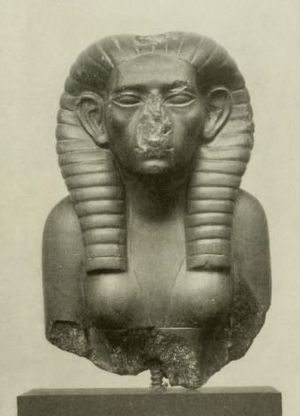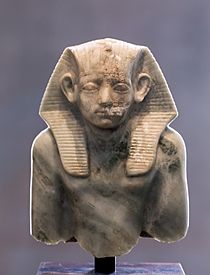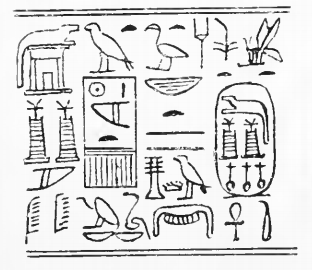Sobekneferu facts for kids
Quick facts for kids Sobekneferu |
|
|---|---|
| Neferusobek Scemiophris from Greek: Σκεμίοφρις |
|

Statue of Sobekneferu
|
|
| Pharaoh | |
| Reign | 3 years, 10 months, and 24 days according to the Turin Canon in the mid 18th century BC. (Twelfth Dynasty) |
| Predecessor | Amenemhat IV |
| Successor | Sobekhotep I or Wegaf |
| Consort | Amenemhat IV? |
| Father | Amenemhat III |
| Burial | Northern Mazghuna pyramid? |
Sobekneferu or Neferusobek (Ancient Egyptian: Sbk-nfrw meaning 'Beauty of Sobek') was a pharaoh of ancient Egypt and the last ruler of the Twelfth Dynasty of the Middle Kingdom. She ascended to the throne following the death of Amenemhat IV, possibly her brother or husband. Her reign lasted 3 years, 10 months, and 24 days, according to the Turin King List.
Sobekneferu was the first ruler to have a name associated with the crocodile god Sobek.
Family
Sobekneferu was the daughter of Pharaoh Amenemhat III, but nothing is known about her mother.
The relationship between Amenemhat IV, Amenemhat III's heir, and Sobekneferu remains unclear. Some believe they were brother and sister. Others think they were probably married. Sobekneferu acceded to the throne after the death of Amenemhat IV either because he had no male heir or because she had decided to usurp the throne, viewing Amenemhat's heirs as illegitimate.
Reign
The Middle Kingdom was in decline by the time of Sobekneferu's accession. She reigned for around 4 years, but as with her predecessor, there are few surviving records. Her death brought a close to the Twelfth Dynasty and began the Second Intermediate Period spanning the following two centuries.
She was succeeded by either Sobekhotep I or Wegaf, who inaugurated the Thirteenth Dynasty.
Contemporary evidence

Only a small collection of sources attest to Sobekneferu's rule as pharaoh of Egypt. The British Museum has a fine cylinder seal bearing her name and royal titulary in its collection. The seal is made of glazed steatite and is 4.42 cm (1.74 in) long with a diameter of 1.55 cm (0.61 in).
A handful of headless statues of Sobekneferu have been identified. In one quartzite image, she blends feminine and masculine dress with an inscription reading 'daughter of Re(?), of his body, Sobekneferu, may she live like Re forever'. On her torso rests a pendant modelled on that worn by Senusret III. Three basalt statues of the female king were found in Tell ed-Dab'a; two depict her in a seated posture, another shows her kneeling. In one, she is depicted trampling the Nine Bows, representing the subjugation of Egypt's enemies. The three statues appear to be life-sized. One statue with her head is known. The bust was held in the Egyptian Museum of Berlin but was lost during World War II.
There is evidence that she had structures built in Heracleopolis Magna and added to the Pyramid of Amenemhat III in Hawara. She left inscriptions on four granite papyriform columns found at a temple in Kom el-Akârib, while a further ten granite beams there may date to the same period. Her monumental works consistently associate her with Amenemhat III rather than Amenemhat IV, supporting the theory that she was the royal daughter of Amenemhat III and perhaps only a stepsister to Amenemhat IV, whose mother was not royal. Contemporary sources from her reign show that Sobekneferu adopted only the 'King's Daughter' title, which further supports this hypothesis.
Funerary monument
Sobekneferu's tomb has not yet been positively identified. The Northern Mazghuna pyramid is assumed to be her monument. There is, however, no clear evidence to confirm this and the pyramid may date to a period well after the end of the Twelfth Dynasty.
See also
 In Spanish: Neferusobek para niños
In Spanish: Neferusobek para niños
- Hatshepsut
- Merneith
- Neithhotep
- Statue of Sobekneferu



